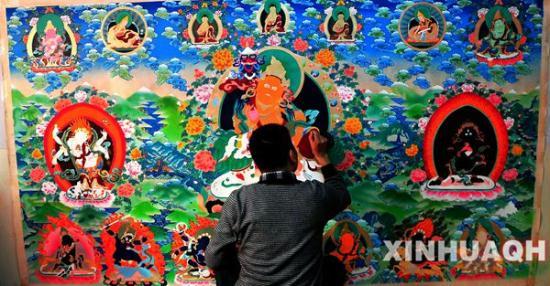Shanghai volunteers work to promote Thangka paintings

 0 Comment(s)
0 Comment(s) Print
Print E-mail CNTV, December 17, 2013
E-mail CNTV, December 17, 2013
We turn now to the art of Xigaze, of the Tibet Autonomous Region. Its Thangka paintings are among the best-known, because of the region's high artistic achievements. But the artists who create them don't earn much, as the artform is still not well known outside the plateau region. Some Shanghai volunteers are looking to change that.
 |
|
Its Thangka paintings are among the best-known, because of the region's high artistic achievements. [File] |
Thangka artist Norbu started studying the technique with a well-known Buddhist temple mural painter in Tibet more than 30 years ago. He says back then, very few people wanted to make a living by painting and selling Thangka, because artists were not the ones who set the value.
Norbu, Thangka Painter, said, "There was no fixed price for a piece of Thangka. If people like it, they can buy it at any price, for example, 100, 200 or 300. Nowadays, it's different. The paintings are charged according to the materials we use. More golden pigments, more expensive."
Norbu says the situation has slowly changed over the years. As more and more people visit Tibet, the outside world is learning more about Thangka and showing a greater interest in it. More than 30 students are working as apprentices in Norbu's studio. They earn 100 yuan for an eight-hour day, and some say they can make a living from their art.
"Very few people learned to paint Thangka in the past. But because many Chinese tourists and foreigners started to like it, it's sold very well. That way, many people started to learn about Thangka." Said Thangka student Jamyang.
"I came here to paint Thangka after I graduated from middle school. One reason is that I like painting. But the most important one is that there are six children in my family, and I'm the youngest. They say now painting Thangka can earn money more easily." Said Thangka student Tsering Dholha.
These students may be among the first to understand that painting Thangka as a career has a promising future. Although a piece of Thangka can be priced at tens of thousands of yuan, it usually takes a novice at least five years of hard work to become proficient only in making the fabric, producing the pigments and sketching. It will take a lot more practice to become a true master who can produce money-making works.
Thangka Painter Phuntsok Trashi said, "The major problems of promoting the art of Thangka is that we have to recruit more students, but since we can't earn that much with our current economic sources, we won't recruit too many. So we hope the government can support us financially so that we can recruit more students."T
That's a problem Shanghai volunteers are trying to resolve. They are trying to get funds from the Shanghai government to subsidize Thangka students and masters. And they are also finding markets for the old Tibetan art, beginning locally in Xigaze. In September, more than 100 Thangka paintings went on display in Xigaze's Zongshan Museum, which was also built by Shanghai volunteers in 2010. Now, they may go beyond the Tibetan plateau.
Hu Wei, Cultural Protection Expert, said, "We hope that we can get some exquisite Thangkas every year, and then select some to send to Shanghai for a big exhibition. This can also add more ethnic elements to the Shanghai cultural market."
Hu says he plans to collect about 200 high quality Thangkas by next June and then exhibit them in July in Shanghai before selling them at an auction. But first he says the Shanghai Cultural Heritage Bureau will pay for buying some Thangkas from the painters in order to support them financially, and maybe try to get the masters to leave Tibet for the first time to visit big cities.
"If our work can be put on display, I believe many people will come to buy it, so we can earn more. I hope they can be displayed in more places, as I haven't been to places outside Tibet." Thangka Painter Hrida said.
Hu says they will try to help Thangka masters to go to more places in Yangtze Delta region to show their work, and says there's a big market potential there.
"We will not only help Thangka masters and their students financially, we will also try to make Mentang Thangka more influential in the market, to help promote and protect the culture." Hu said.






Go to Forum >>0 Comment(s)